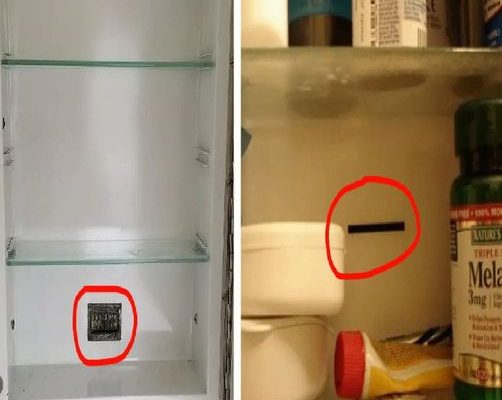Over the years, my husband and I have flipped quite a few old houses, uncovering countless unexpected treasures along the way. From wads of antique currency concealed within walls to vintage glass bottles buried beneath floorboards—each discovery tells a unique story about the past. But among the quirks we’ve encountered, one peculiar feature of old homes stands out: the razor blade slot in vintage medicine cabinets.

A Mysterious Slit in the Medicine Cabinet
If you’ve ever explored a house built more than a century ago, you might have noticed something unusual in the bathroom. Many older homes still have their original medicine cabinets, often with a small, narrow slit cut into the back wall. This subtle feature is easy to miss, yet it served an essential purpose in its day.
Back in the early 20th century, stainless steel razor blades, as we know them today, didn’t exist. Instead, men shaved with thin metal blades that dulled quickly and needed frequent replacement. These used blades presented a problem: disposing of them safely. Simply tossing a sharp blade into the trash posed a significant risk of injury, especially in homes with curious children or pets.
The Ingenious Razor Blade Disposal System
To address this issue, homes were designed with a clever solution: the razor blade slot. After a blade was no longer usable, it could be slipped through the slot in the back of the medicine cabinet. The blade would fall into the empty space between the wall studs, out of sight and safely away from harm.
This disposal method was remarkably effective for its time. It prevented injuries and kept sharp objects out of household trash, long before safety containers or disposable razors became standard. The wall effectively became a permanent storage space for used blades—a quirky but practical “tomb” for these small, sharp tools.
A Quirky Discovery in Modern Renovations
Fast forward to today, and this disposal practice feels almost absurd. But back then, it made perfect sense. Without modern safety systems, households had to devise creative solutions for everyday challenges.
During renovations, encountering these razor blade deposits can be both baffling and fascinating. The first time my husband and I opened a wall to find a pile of rusted blades, we had no idea what we were looking at. After some research, we learned this was a widespread practice in homes built before the 1960s. The discovery felt like stepping into a time capsule, offering a glimpse into how people solved practical problems decades ago.
A Glimpse Into the Past
It’s remarkable to think about how a feature as small as a razor blade slot reflects the ingenuity of earlier generations. Today, we have designated containers, recycling programs, and advanced disposal systems for sharp objects. But back then, people made do with what they had, and their solutions were often just as effective.
These discoveries remind us that the ordinary can become extraordinary with the passage of time. Every detail in an old home—no matter how small—has a story to tell about how people lived, adapted, and solved problems in their era.
So, if you ever find yourself in an old house, take a closer look at the medicine cabinet. If you spot that little slit, you’ll know its purpose and the bit of history it carries. Who knows what other fascinating quirks lie hidden behind the walls of vintage homes?



